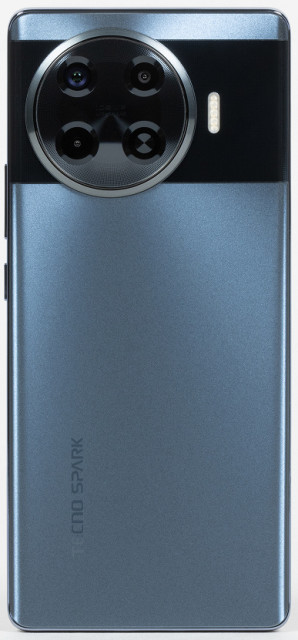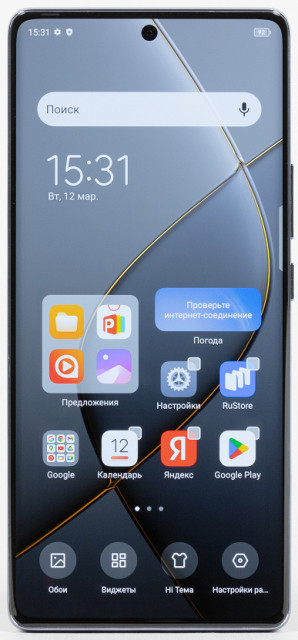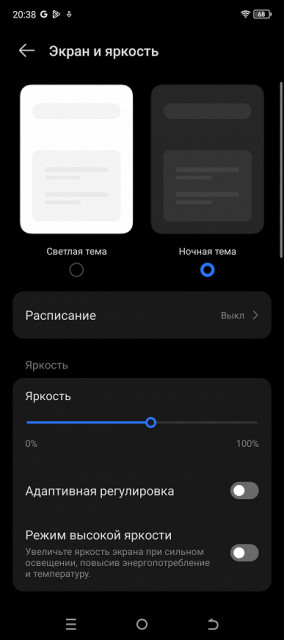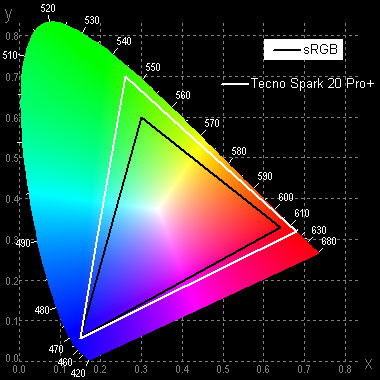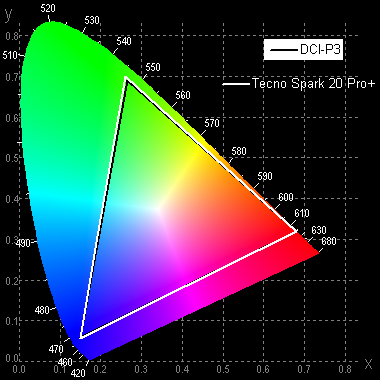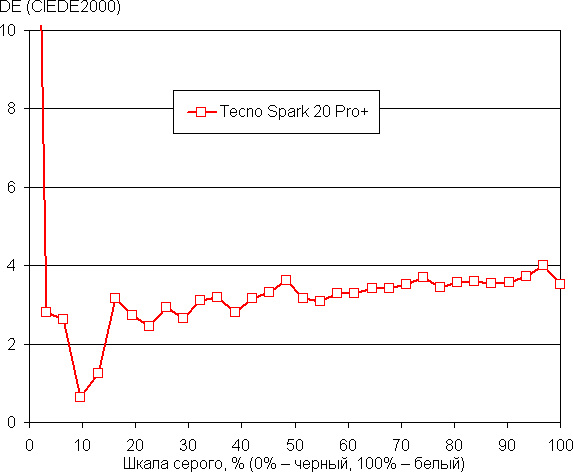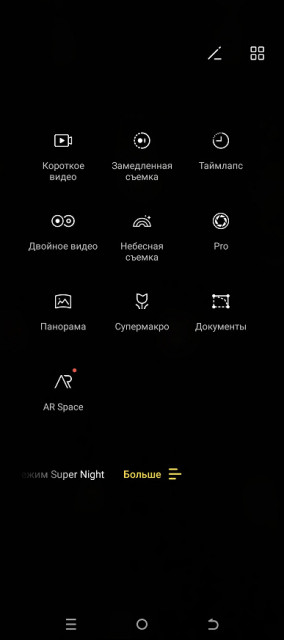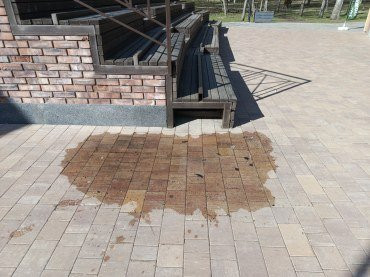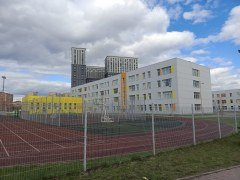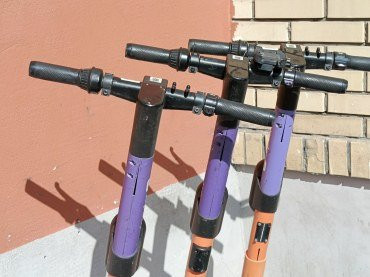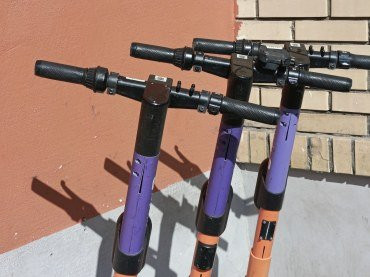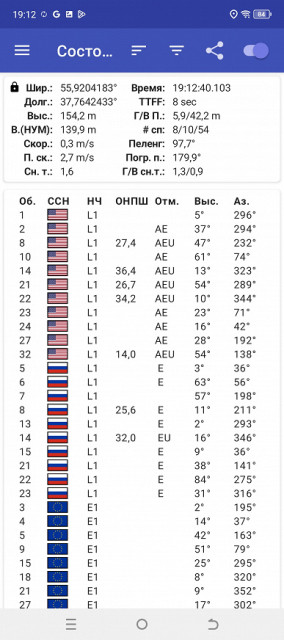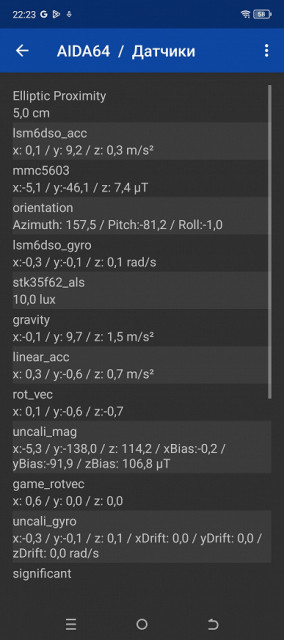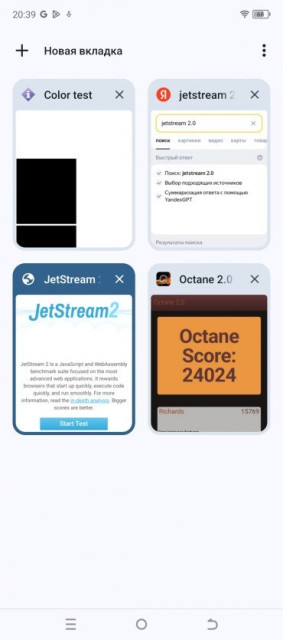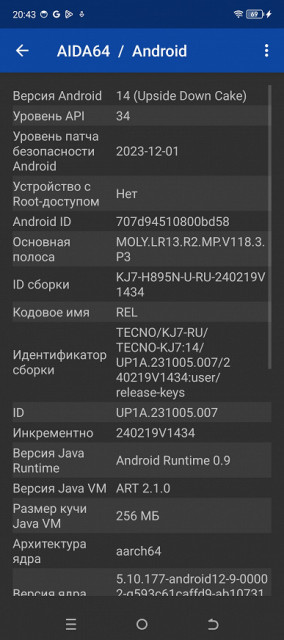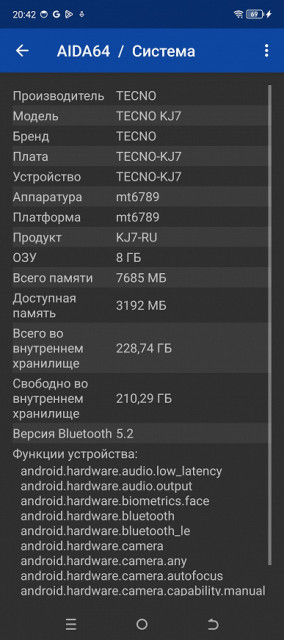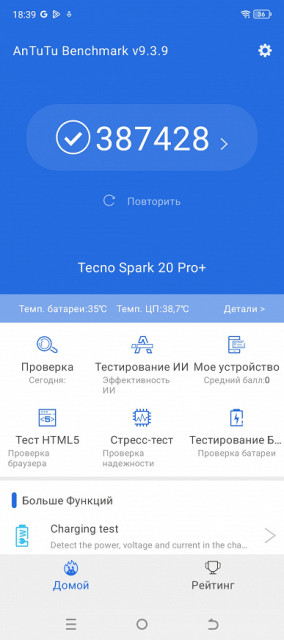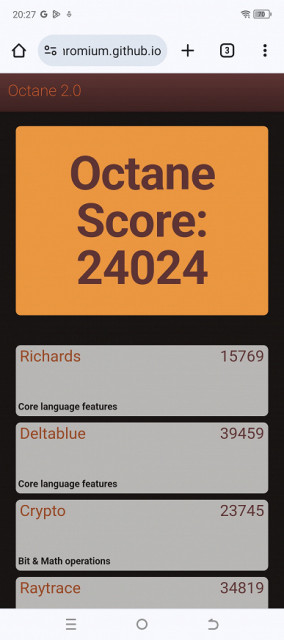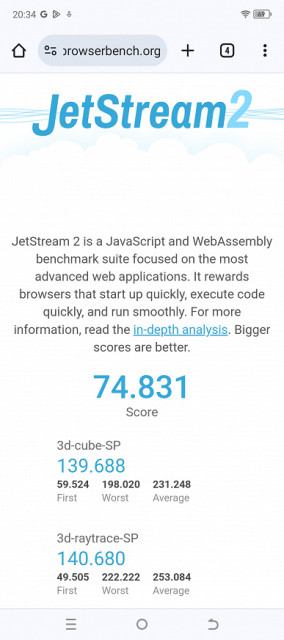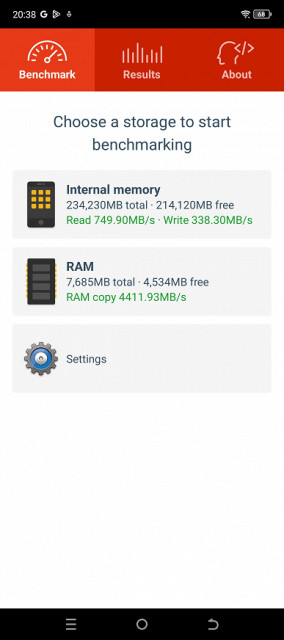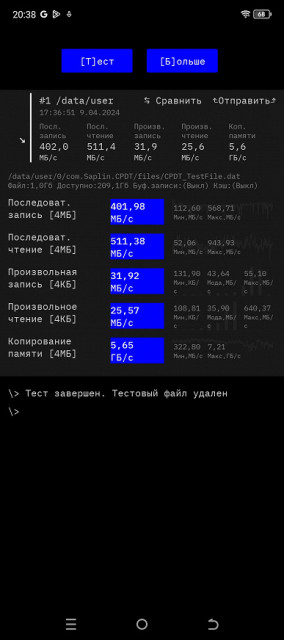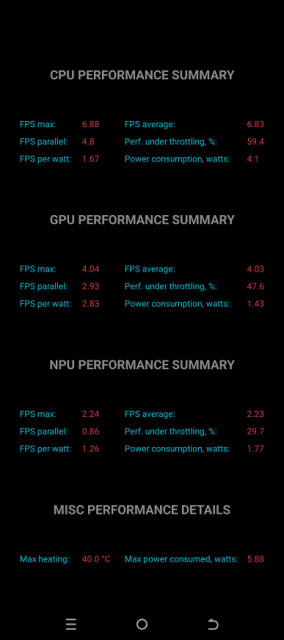This mid-range smartphone has some limitations: its MediaTek hardware platform isn't the most powerful, but its AMOLED screen stands out. The cameras and battery life are not impressive. It doesn't have cutting-edge features, but its stylish design with a curved screen makes a good impression. You shouldn't expect outstanding technical performance from it, but it does stand out in appearance.
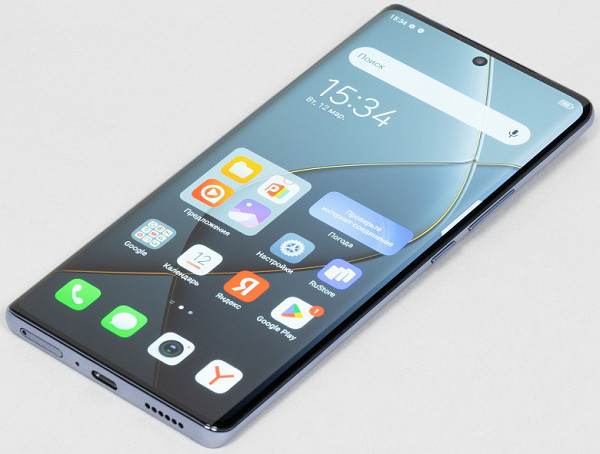
Key Features of Tecno Spark 20 Pro+
- SoC Mediatek Helio G99 Ultimate, 8 processor cores (2×Cortex-A76 @2.2 GHz + 6×Cortex-A55 @2.0 GHz)
- GPU Mali-G57 MC2
- Operating system Android 14
- Touch display AMOLED, 6.78″, 1080×2436, 20:9, 393 ppi, 120 Hz
- RAM 8 GB, internal memory 256 GB
- No microSD support
- Nano-SIM support (2 pcs.)
- Networks 2G GSM, 3G WCDMA, 4G LTE
- GPS, Glonass, BDS, Galileo
- Wi-Fi 5 (2.4 and 5 GHz)
- Bluetooth 5.2, A2DP
- NFC
- USB 2.0 Type-C, USB OTG
- There is no 3.5mm audio output for headphones
- Cameras 108 MP + 2 MP, video 2.5K (1440р@30 fps)
- Front camera 32 MP
- Proximity and lighting sensors, magnetic field, accelerometer, gyroscope
- Fingerprint scanner (under the screen)
- Battery 5000 mAh, charging 33 W
- Dimensions 165×75×7.6 mm
- Weight 179 g
Appearance and ease of use
The Tecno Spark 20 Pro+ smartphone comes in a hard cardboard box with a colorful design.

The relatively rich kit includes a 33 W power supply, a connecting cable, a transparent flexible case, and a protective glass with curved edges for the screen.
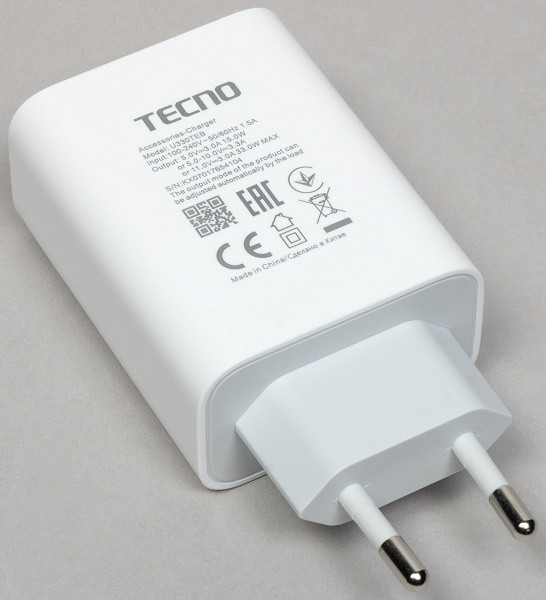
Tecno Spark 20 Pro+ is a sophisticated and stylish device with a design inspired by classic elements. Its feature is a curved “waterfall” screen, previously characteristic of flagship models, now available in the mid-price segment. However, its sleek body can be slippery due to the narrow sides and curved glass of the screen, making it difficult to grip.

However, the device looks great on the table: its refined body has fine lines and a matte finish on the back, a neat camera array adorns the rear panel, and a thin chrome frame adds charm to the sides.

Although the body materials are not premium — the frame is made of plastic with a metallic coating, and the back is also made of plastic, embellished with a frosted glass effect, the device still looks stylish. Its narrow sides make it appear even thinner than it actually is, and its weight is less than 180g, making it comfortable to carry in your pocket.
The side buttons are thin and harsh, they are in their proper places right under the finger.

However, there are problems with the included case. It’s not entirely clear what the developers were thinking, but the hole for the USB Type-C connector is too narrow, which does not allow the use of third-party plugs — they simply do not reach the contacts of the device. This forces you to remove the cover, which is inconvenient. In addition, the case does not have cutouts for the side buttons, and the thick pads make pressing them even more difficult. In general, it is recommended to replace the case with another one.
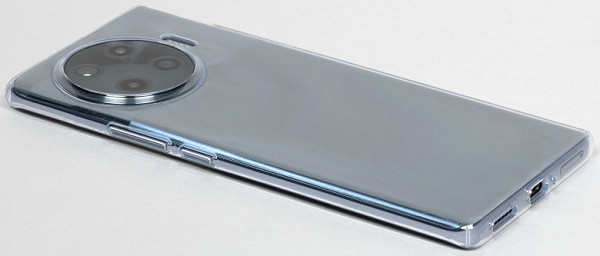
The camera cluster on the back is a fascinating look, with a neat round design that symmetrically collects the cameras, but they're offset towards the corner to avoid your fingers blocking the optics. The developers deserve praise for this approach. It is also worth noting the presence of a powerful flash consisting of several LEDs. However, as for the cameras themselves, there are only two presented here, and only one of them is full-fledged.

A single front camera eye is installed behind a circular cutout in the screen matrix in the center of the top edge.

The fingerprint scanner is located under the bottom of the screen glass. This optical device is quite fast, although many users find the side-button scanner more convenient. However, due to the thin sides, it was hardly possible to place a scanner there, since the buttons are too narrow.
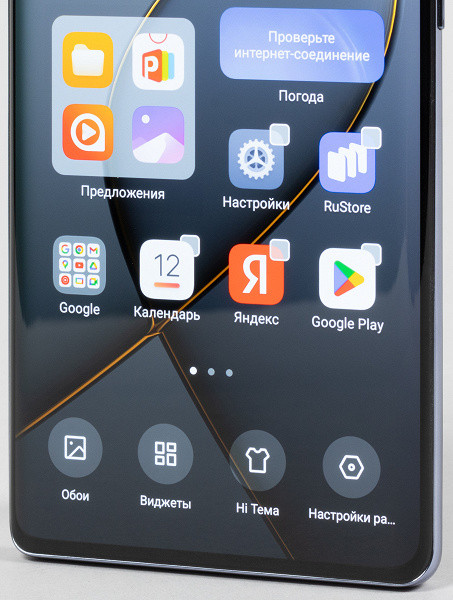
The slot on the bottom can accommodate two Nano-SIM cards (on one side and the other side of the sled). Installation of a microSD memory card is not provided.

A speaker, microphone and USB Type-C connector are also installed here at the bottom end.

The top edge contains an additional microphone and a second speaker, so this smartphone has stereo speakers.

This device is available in various color options, including the popular eco-leather option. It provides IP53 water and dust protection to the case, which protects the smartphone from water splashes and allows you to use the touch screen even with wet fingers during rain. However, the device is not designed to be completely submerged in water.

Screen
The Tecno Spark 20 Pro+ smartphone features a 6.78-inch AMOLED display with a resolution of 1080×2436 (20:9), protected by Corning Gorilla Glass 5 with curved edges. The physical dimensions of the screen are 70x157 mm, with a pixel density of 393 ppi. The frames around the screen are narrow: 2 mm on the sides and 3 mm on the top and bottom. The screen supports a 120Hz refresh rate.
The front surface of the screen is made in the form of a glass plate with a mirror-smooth surface that is scratch-resistant. The anti-glare properties of the screen are superior to those of the Nexus 7. An oleophobic coating is applied to the surface of the screen, which improves readability and reduces fingerprints.
The maximum screen brightness is about 520 cd/m² under normal conditions and can reach 730 cd/m² when High Brightness Mode is activated. The minimum brightness value is 2 cd/m², ensuring comfortable use in the dark. The automatic brightness adjustment function adequately adjusts the brightness to the external conditions.
At high and medium brightness levels there is modulation with a frequency of about 60 or 120 Hz.
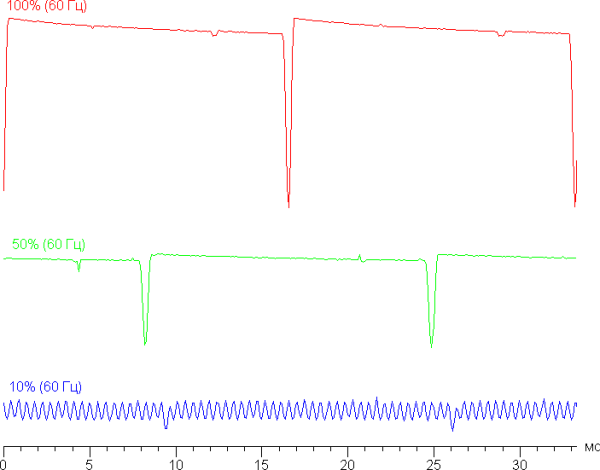
When observing at high and medium brightness levels, a low modulation frequency (60 Hz) is noticeable, but the modulation duty cycle is also low, and the modulation phase varies across the entire screen area, which eliminates visible flicker. When brightness is reduced significantly, modulation occurs at a higher frequency (2.16 kHz), but there is still no visible flicker.
In the screen settings there is an option to enable a mode with an increased refresh rate of up to 120 Hz.

In 120 Hz mode, scrolling smoothness is noticeably improved. Let's see if this changes the nature of the modulation. 120Hz mode:

At high and medium brightness, the modulation frequency increased to 120 Hz, while maintaining a low modulation amplitude at low brightness. It is important to note that there is no visible flicker.
This display uses an AMOLED matrix based on organic light-emitting diodes. A full-color image is formed using subpixels of three colors: red ®, green (G) and blue (B). However, the number of red and blue subpixels is half as much, which corresponds to the RGBG layout. This is confirmed by a microphotograph of a fragment of the display.
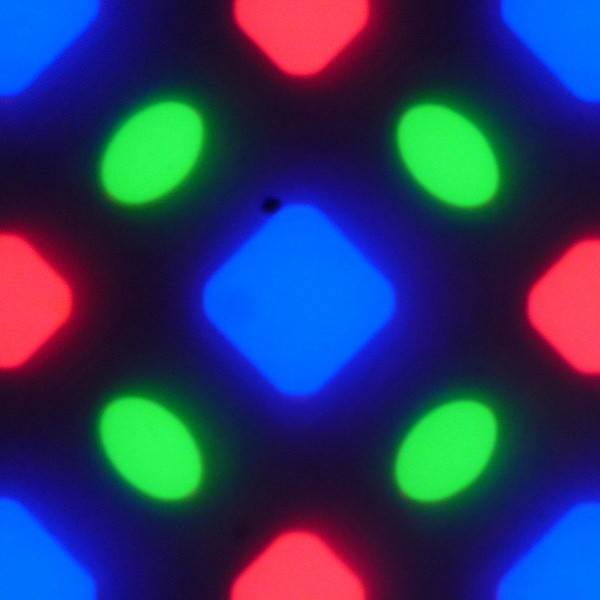
The fragment shows 4 green subpixels, 2 red (4 halves) and 2 blue (1 whole and 4 quarters). These fragments can be repeated without breaks or overlaps, which corresponds to the PenTile RGBG matrix. Screen resolution is assessed by green subpixels, since they predominate. However, due to some artifacts and uneven contrast edges that are found on such matrices, image quality may suffer slightly, although due to the high resolution this impact is minimal.
The screen has excellent viewing angles. Although white may take on a slight blue-green tint at high viewing angles, black remains rich and consistent at all angles. The black quality is so high that the contrast setting becomes unusable. For comparison, photographs are presented with the smartphone and Nexus 7 screens, displaying the same images at similar brightness and color balance, which was set on the camera at 6500 K.
There is a white field perpendicular to the screens.

The uniformity of brightness and color tone of the white field is high, with the exception of subtle darkening and changes in hue towards the curved edges.
Below is the test picture (Original Color profile):

Colors on the smartphone screen look oversaturated, which is noticeable in tomatoes, bananas, napkins and facial shades. However, it should be noted that photography is not a sufficiently reliable source for assessing the quality of color rendering, since the camera can distort the perception of color due to differences in spectral sensitivity with the matrix of human vision.
The «Original Color» color rendering profile was selected in the screen settings when this photo was taken. Please note that this image fills the entire available screen area and even extends to the curved edges, which may result in slight darkening and color distortion. Also, such areas are often subject to glare in the presence of lighting, which can interfere with viewing images on the entire screen.
The photo also shows that the picture of films with an aspect ratio of 16:9 also overlaps the bends, which can create inconvenience when watching movies.

When choosing the first, Vivid Colors, the colors are even more oversaturated and unnatural:

This effect is achieved by slightly expanding the color gamut and greatly increasing color contrast. In addition, you can adjust the shade from cool to warm.
The decrease in brightness at viewing angle occurs both in conventional LCD screens and in smartphones, but in the case of the latter it is less pronounced. This makes the mobile device screen visually brighter, especially when viewed from a low angle, which is typical for mobile devices.
Switching the state of the matrix elements occurs almost instantly, however, at the switching edge, a step with a width of approximately 17 ms (at a screen refresh rate of about 60 Hz) or approximately 8 ms (at 120 Hz) can be observed.
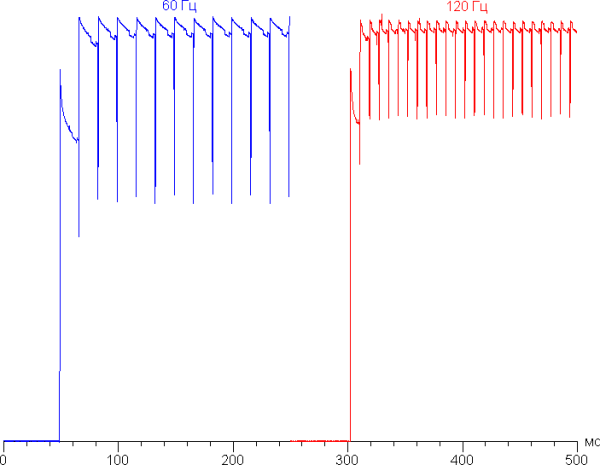
In some cases, the presence of such a step can cause trails that trail behind moving objects.
The gamma curve, built on the basis of 32 points with equal intervals according to the numerical value of the shade of gray, showed no blockages in the shadows or fumes in the highlights. The exponent of the approximating power function is 2.28, which is slightly higher than the standard value of 2.2. In this case, the real gamma curve only slightly deviates from the power-law dependence.
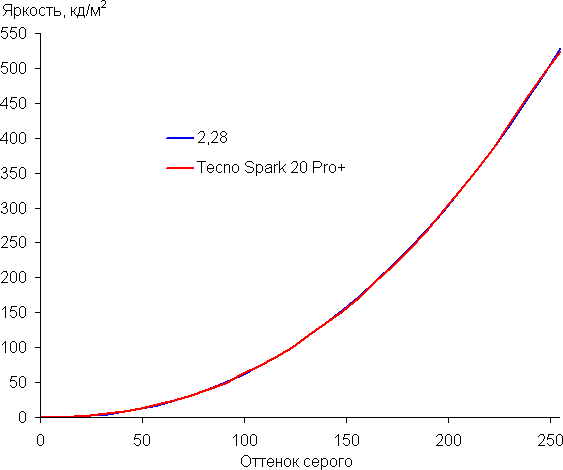
Recall that OLED screens dynamically change the brightness of parts of the image depending on the nature of the output content, which can lead to a slight decrease in brightness for overall bright images. Because of this, the resulting gamma curve is likely to differ slightly from the gamma curve of a static image, since the measurements were taken with sequential grayscale output across almost the entire screen area.
The color gamut, even when using the «Original Color» profile, significantly exceeds sRGB and is very close to the DCI-P3 space.
In the case of the Vivid colors profile, the color gamut is slightly wider than DCI-P3:

In this case, the component spectra (that is, the spectra of pure red, green and blue) are very well separated:

In the case of the Original color profile there is already a slight cross-mixing:
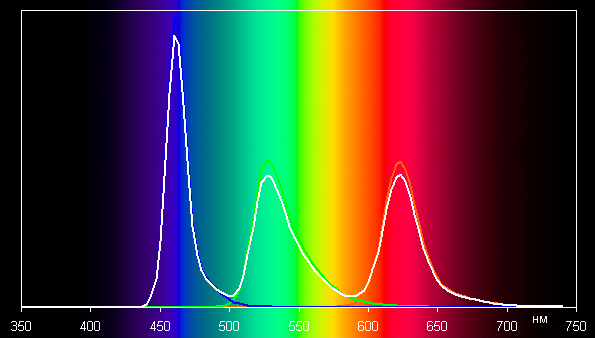
The balance of shades on the gray scale is a compromise: the color temperature is noticeably higher than the standard 6500 K, but the deviation from the blackbody spectrum (ΔE) is less than 10 units, which is considered a good indicator for a consumer device. At the same time, both color temperature and ΔE change little from hue to hue, which has a beneficial effect on the visual assessment of color balance.
The balance of shades on the gray scale is a compromise: the color temperature is noticeably higher than the standard 6500 K, but the deviation from the blackbody spectrum (ΔE) is less than 10 units, which is considered a good indicator for a consumer device. At the same time, both color temperature and ΔE change little from hue to hue, which has a beneficial effect on the visual assessment of color balance.

Setting the color balance correction to reduce the intensity of the blue component is not recommended, since even at the minimum correction the color temperature remains below the standard 6500 K (5800 K). In this case, it is better to leave all settings at default to ensure maximum brightness.
Apparently, this device does not support DisplayPort Alt Mode for USB Type-C, which means it is impossible to output image and sound to external devices when connected to the USB port.
So, the screen has a very high maximum brightness (up to 730 cd/m², exactly 520 cd/m²) and excellent anti-glare properties, which allows you to use the device even in bright sunlight. In complete darkness, the brightness can be reduced to a comfortable level (up to 2 cd/m²). The automatic brightness adjustment mode works adequately. The advantages of the screen include an effective oleophobic coating and a mode with an increased refresh rate of up to 120 Hz. However, the wide color gamut may result in color distortion when viewing videos and photos. Overall, the image quality is high. Separately, it should be noted that the curved edges of the screen introduce distortion in color tone and reduce brightness at the edges of the image, which can be a disadvantage, especially in ambient light conditions.
Camera
The Tecno Spark 20 Pro+ smartphone is equipped with a set of two rear cameras and one front camera.
- 108 MP, 1/1.67″, 0.64 µm, f/1.8, PDAF (main)
- 2 MP, f/2.4 (macro)
- 32 MP, 1/3.1″, 0.7 µm, f/2.2 (selfie)
The main camera has fast and accurate phase detection autofocus, but there is no optical stabilizer. By default, pictures are taken at 12 megapixel resolution with pixel binning, but you can switch to shooting at full 108 megapixel resolution. While full-size photos can provide additional detail, this mode is extremely sensitive to lighting conditions and can significantly reduce quality in cloudy moments when the sun is hidden behind the clouds. The 108 megapixel shooting mode can be considered optional, but it is recommended to duplicate each such photo in 12 megapixel format, since the flaws in the frame may not be obvious on the smartphone screen.
With sufficient lighting, photographs are quite acceptable, corresponding to an average level of quality. While detail may not be as impressive as flagship devices, images remain crisp and sharp overall. However, they are often a little overexposed, lack contrast and volume, and look pale. If possible, it is recommended to experiment with the settings and try lowering the shutter speed in manual mode for more expressive shots.
Here are a few more examples of pictures taken with the main camera in automatic mode:
In night mode, exposure remains high, but the sensor can no longer retain sufficient detail, resulting in weak results. Although automatic noise correction largely copes with noise, it still gets lost along with fine details.

Digital zoom in this case is carried out by using the central part of a full-size 108-megapixel image. This preserves enough detail to allow photographs to be used at 3x magnification.
The secondary 2-megapixel camera is designed for macro photography, but like other cameras of this type, it fails to offer anything truly interesting. Much better macro photos can be obtained using the main camera with zoom function.

snapshot on a special “macro module”

shot with the main camera with digital zoom
The maximum video shooting mode is 2.5K (1440p) at 30 frames per second, which is limited by the processor, which is worth noting. Image quality in this mode is quite good with good detail and adequate sharpness, but the lack of stabilization in the maximum mode is a serious drawback, especially for shooting on the move. At 1080p resolution, electronic stabilization is activated, but it is not ideal; visible image twitching and a “jelly effect” appear. It is recommended to use this smartphone for shooting in a static position, since active shooting in motion is not for it. The sound is recorded a little muffled, probably due to the noise reduction system.
The front camera module is the only one, however, thanks to digital zoom, you can simulate two different focal lengths. Although this camera is also prone to overexposure, the image may appear lackluster and flat. However, detail is generally acceptable and color reproduction is natural.
Telephone and communications
The Tecno Spark 20 Pro+ comes with standard networking capabilities. Most 4G mobile network bands, two Wi-Fi 5 bands and Bluetooth 5.2 are supported. There is also NFC support. However, 5G networks and e-SIM support are missing. Within the city limits of the Moscow region, the device demonstrates reliable operation in wireless networks, without losing connection and quickly restoring it after a break. All the necessary built-in sensors, including a gyroscope, are available.
The satellite navigation module supports GPS, Glonass, BDS, Galileo and QZSS. During a cold start, the first satellites are quickly detected, and the positioning accuracy is not satisfactory.
The interlocutor's voice in the speaker is loud enough, and speech is clearly intelligible. The vibration alert has average power. VoLTE and VoWiFi functions are also implemented.
Software and multimedia
Tecno Spark 20 Pro+ runs on Android 14 operating system with HiOS 13.6 skin. When compared with Realme and Redmi, the Tecno shell noticeably wins in cleanliness, conciseness, lack of advertising and a minimum number of pre-installed applications. This aspect is worthy of recognition by users, and the credit for this goes to Tecno representatives. The control curtain is divided into two parts. Official Google Play app store and on-site access to Google services.
The Always-On feature on this smartphone is limited: the screen does not stay on all the time, but only activates when touched to display information. If the device is placed on a stand on the night table, the clock does not appear on the screen. This is obviously done to save energy. The trendy Dynamic Port feature, similar to Dynamic Island, creates a dynamically displayed area around the front camera with basic functionality.
The Tecno Spark 20 Pro+ speakers sound very impressive: the sound is loud, bright, clear, conveys volume well and is not inferior in quality in the mid and low frequencies. However, there is no 3.5mm audio output for connecting wired headphones. Instead, there is support for DTS technology with presets for music, movies and games. In general, the device has a decent audio system.
Performance
The Tecno Spark 20 Pro+ smartphone is powered by an octa-core Mediatek Helio G99 Ultimate processor and Mali-G57 MC2 GPU. It has 8 GB of RAM (plus another 8 GB of virtual memory) and 256 GB of internal storage. Unfortunately, it is impossible to expand the memory using a memory card, but there is support for connecting external devices via the USB Type-C port in USB OTG mode.
The Mediatek Helio G99 Ultimate platform is an improved version of the Mediatek Helio G99. Although it scores slightly higher in AnTuTu, the performance is still not at the highest level. However, this is enough for everyday tasks and smooth operation of the interface. It is also capable of running games, although not at the highest settings, but without serious overheating.
Testing in comprehensive tests AnTuTu and GeekBench:
To make it easier to summarize the results of smartphone testing in the latest versions of popular benchmarks, we have created tables. These tables usually include the results of several other devices from different segments, also tested on similar versions of the benchmarks. This allows you to clearly compare the obtained numerical data. Unfortunately, within the framework of one comparison it is impossible to take into account the results from different versions of benchmarks, so many worthy and relevant models remain outside the scope of our analysis.
| Tecno Spark 20 Pro+ (Mediatek Helio G99 Ultimate) | Huawei nova 12s (Qualcomm Snapdragon 778G) | OnePlus Nord 3 5G (Mediatek Dimensity 9000) | Realme 12 Pro+ (Qualcomm Snapdragon 7s Gen2) | Redmi Note 13 Pro+ (Mediatek Dimensity 7200 Ultra) | |
|---|---|---|---|---|---|
| AnTuTu (v9.x) (bigger is better) | 387428 | 546957 | 789188 | 576685 | 669583 |
| GeekBench 6 (bigger is better) | 744/2019 | 996/2453 | 1077/3175 | 894/2801 | 1126/2643 |
Testing the graphics subsystem in GFXBenchmark gaming tests:
| Tecno Spark 20 Pro+ (Mediatek Helio G99 Ultimate) | Huawei nova 12s (Qualcomm Snapdragon 778G) | OnePlus Nord 3 5G (Mediatek Dimensity 9000) | Realme 12 Pro+ (Qualcomm Snapdragon 7s Gen2) | Redmi Note 13 Pro+ (Mediatek Dimensity 7200 Ultra) | |
|---|---|---|---|---|---|
| GFXBenchmark Aztec Ruins OpenGL (Onscreen, fps) | 16 | 34 | 96 | 35 | 50 |
| GFXBenchmark Aztec Ruins Vulkan (Onscreen, fps) | 14 | 38 | 105 | 39 | 55 |
| GFXBenchmark Car Chase ES 3.1 (1080p Offscreen, fps) | 15 | 33 | 79 | 30 | 43 |
| GFXBenchmark Manhattan ES 3.1 (1080p Offscreen, fps) | 26 | 56 | 151 | 54 | 74 |
| GFXBenchmark T-Rex (1080p Offscreen, fps) | 64 | 133 | 293 | 122 | 191 |
Testing in browser cross-platform tests:
| Tecno Spark 20 Pro+ (Mediatek Helio G99 Ultimate) | Huawei nova 12s (Qualcomm Snapdragon 778G) | OnePlus Nord 3 5G (Mediatek Dimensity 9000) | Realme 12 Pro+ (Qualcomm Snapdragon 7s Gen2) | Redmi Note 13 Pro+ (Mediatek Dimensity 7200 Ultra) | |
|---|---|---|---|---|---|
| Google Octane 2 (bigger is better) | 24024 | 24923 | 29390 | 30529 | 39276 |
| JetStream (bigger is better) | 75 | 67 | 76 | 85 | 79 |
Memory speed test results:
Heat
We test for performance degradation when heated using the Burnout Benchmark program, which allows you to load the CPU, GPU and NPU:
| Stress on | Heating performance as a percentage of maximum |
|---|---|
| CPU | 60% |
| GPU | 48% |
| NPU | 30% |
Battery life
The Tecno Spark 20 Pro+ smartphone comes with a 5000mAh battery, which is considered standard by today's standards. However, in tests its autonomy was not very high.
Testing was conducted at normal power consumption levels without using power-saving features, although such features are available on the device. Test conditions: the minimum comfortable screen brightness is set (approximately 100 cd/m²). Tests included continuous reading in the Moon+ Reader app (using the standard light theme), continuous viewing of HD video (720p), and the game Injustice 2 with automatic graphics settings.
| Battery capacity | Reading mode | Video mode | 3D Game Mode | |
|---|---|---|---|---|
| Tecno Spark 20 Pro+ | 5000 mAh | 18 h. 00 m. | 14 h. 00 m. | 6 h. 00 m. |
| Vivo V30 | 5000 mAh | 23 h. 00 m. | 21 h. 00 m. | 8 h. 00 m. |
| Vivo V29 | 4600 mAh | 21 h. 00 m. | 19 h. 00 m. | 8 h. 30 m. |
| Infinix GT 10 Pro | 5000 mAh | 20 h. 30 m. | 18 h. 00 m. | 8 h. 30 m. |
| Tecno Camon 20 Pro 5G | 5000 mAh | 19 h. 00 m. | 16 h. 00 m. | 7 h. 00 m. |
| Vivo V27 | 4600 mAh | 25 h. 00 m. | 19 h. 00 m. | 7 h. 00 m. |
All this data is presented in ideal conditions, without any SIM cards installed. Any changes in smartphone use may reduce these results.
Using the included 33 W mains charger, the smartphone can be charged in an hour and a half. Wireless charging is not supported.
Bottom line
Mid-range smartphone: although the MediaTek hardware platform is not impressive, the AMOLED screen stands out; Cameras and autonomy are not up to par. However, this device lacks advanced features. However, its attractive body with a waterfall screen creates a pleasant impression upon closer acquaintance.

